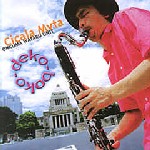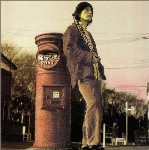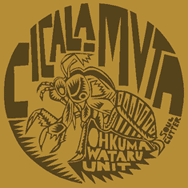discography
in english
CICALA-MVTA
GHOST CIRCUS

TLCA1011/2940yen(with tax)
Little More Records : info@tractor.co.jp
Tractor Enteratinment Inc
tel:+81-(0)3-3408-8824 fax:+81-(0)3-3401-1052
the 3rd Album of "CICALA-MVTA" released on May 2004
Welcome to "Ghost Circus"by Cicala-Mvta
Sounds close to the ground. Cicala-Mvta's music sometimes sounds like that. The band starts to play slowly and begins to stride on the ground powerfully. Sometimes they lash about the ground, and and run fast forward. They are not an underground group. Yet, they don't ascend nor float. They just go forward close to the ground.
A question is asked whether music is something to progress. Listening to Cicala-Mvta, I can believe that there lies much ground to go forward. They go forward on the surface of the globe, a sphere. It may not be progress. Terms such as experiment and evolution do not fit Cicala-Mvta. Their ceaseless march has a texture that has a much more hard-core nature.
Ten years ago, Wataru Okuma, the clarinet player, initiated this group. The <Ghost Circus> published in 2004 is their third album. It seems that by now they have become a one solid mass. They consist of very idiosyncratic players, and they make up a fairly unique instrumental ensemble. Yet, they move forward as a mass. As though they were a three-piece hard-core punk band.
With circus and street band music as their signature, Cicala-Mvta tries amalgamation of various music on the globe, and their music is almost impossible to analyze. The diverse musical elements each musician has absorbed physically in their bodies merge in an instant, and a spark of unique and allomorph music appears. As the album title shows, any academic scrutiny would be absurd-a sonic circus! It supercedes the speed of our thinking.
Their wordless music has become all the more eloquent and carries a message. Full of love, humor and rebellious spirit, their music is a tribute to people on earth who has but to survive. Sometimes it sounds like a requiem. In <Ghost Circus> one also hears and sees dead people singing and dancing in celebration together with Cicala-Mvta. It may be interesting to quietly follow them from behind, and you will probably come across something unseen and unheard. (text by Takahashi Kentaro)
----------------------------------------------------------------------
Notes by OHKUMA Wataru
1.Ghost Hymn Introduction (composed by OHKUMA Wataru)
When I see a glaring evening glow in the sky, I feel grand,and it makes my heart bigger. This piece represents that feeling. At first we thought we'll make it the finale music. But in the end, it was reversed. The ending piece opens the album.
2.Pillow Walk(composed by OHKUMA Wataru)
It was made as the starting piece for a fictitious event. At the top, so it is a pillow. A walking pillow-nice image, isn't it?
3.The United People Will Never Be Defeated (composed by Sergio Ortega)
The original music is known through the new-folklore songs popular in the anti-military clique movement in Chile some 30 years ago and through the American composer FREDERIC RZEWSKI's arrangement. About 20 years ago I took part in a concert in Tokyo, and when this music started, a refugee activist from Chile who happened to be in the audience came to the stage and joined us to sing the song. Since then this beautiful melody has become one of my most intimate songs. But it is the first time I record it with my own group.
4.Stara Planina (composed byYOSHIDA Tatsuya)
The title is taken direcitly from the name of one of the Balkan Mountains. You can fijnd this word on a map. This is the very first piece composed by the other member of Cicala-Mvta. One day I asked Yoshida what did the mountain impress him. For me, generally the mountains are interesting as the claim of the terrain. But what appealed him was the echoes or insistence of the rocks.
5.The Sleep-walker's Escape (composed by OHKUMA Wataru)
The first mood is that of an escape from a bad nightmare. It reminds me of a character that appears in the film <Dr. Caligari>. As a young boy I saw a beautiful picture of a sleep-walker, Cezare, in an old encyclopaedia. Fearful but tempting.
6.Dr. Caligari's Side Show (composed by OHKUMA Wataru)
Initially I did not start making this piece with the image of that expressionist film. It was only a word play. But in actually recording situation, we played an enigmatic harmony in the introduction. Maybe we got close to the doctor’s world.
7.HERAKLION (composed byYOSHIDA Tatsuya)
Is this from a Greek mythology or an association of a “ruins” freak? Yoshida's particular phrases spark here and there. The energy when we played it went far beyond any measuring detector.
8.Song of the Birds (theme arrangement by Chino Shuichi)
Taken from the well-known Catalan song, which greatly owes to Pablo Casals's play. Also the birds sing "peace,peace" in my homeland Catalan, he announced when he played this number in the hall of the UN in New York to protest the fascist government of Franco.
9.The Beam and the Bellows (composed by OHKUMA Wataru; motif by SHINODA Masami)
The basis of this piece is the phrase that Shinoda injected to the music we made together for a film depicting the struggle of manual day-workers of Sanya (1985). It was short and simple, but intriguing. I decided to make a piece with them on the occasion of the 10th anniversary of his death. The title is inspired by the phrase of a poem by Miyazawa Kenji, "A Pipe Organ Made of Light."
10.The Right to Live in Peace (composed by Victor Jara)
On one hand I wanted to send the message of this song (and those of The Song of the Birds and The United People Will Never Be Defeated) to this idiotic and lukewarm time. While on the other hand, I feel it suffices just playing this simple and beautiful melody. It has a capacity for a long flight.
11.Ghost Requiem (composed by OHKUMA Wataru)
This requiem is for those who had to die out of absurdity. The initial kick came from the death of a graduate school student in Kobe who was killed by absurd violence and by negligence of the police. He used to listen to Cicala-Mvta music, and I started writing the music. It eventually evolved to be a suite.
Since then I had to hear about many more deaths of people close to me and us. Deaths must be borne by collective souls.
Thanks to everyone who pushed our back forward.
deko-boko

RES-55/2940yen(with tax)
Respect Record
info@respect-record.co.jp
tel:+81-(0)3-3746-2503 fax:+81-(0)3-3746-2572
the 2nd Album of "CICALA-MVTA" released on Oct. 2001
TOKYO JINTA / STEEP SLOPE / DEKO BOKO / A WEEKEND OF A CLOWN / THE BLEU FLOWER KOPANITZA / SORRY FOR FALLING IN LOVE WITH YOU ! / DHON CHORECHA VARIATION / BESSARABIAN HORA / BULGARIAN RHYTHM / ALBERT AYLER MEDLEY / JERRY ROLL / MOTTO KYU NA SAKA
1.TOKYO JINTA [by OHKUMA Wataru]
When I started to learn clarinet in chin-don tradition in mid 80's,
I found that there were also the elements of the jinta tradition ,which was believed as the things of the past ,was surviving in chin-don,although hanged by a thread.
In short words, Jinta is japanese street brassband mostly organized for advertising or to play for silent movies or for circuses. And its origin is the military brass band , which is the first western music formally imported into Japan as one of the military technology in the mid19th century . The military brassband not only play heroic marches but western classics, to demonstrate the civilized music for the people.
But it didn't take a long time to find it's cheap imitators in the down-town. Most of those commercial bands were recognised to be vulgar or kitsch , but popular in the downtown. People intimately called those bands "Jinta" , one of the predecessor of chin-don.
The barker's voice in this introduction is for "Misemono-goya", a kind of japanese freak show. You can see like the snake-eating lady or fire blower in their street tent theater, but also this tradition is going to disappear in the twilight of the history. This barker Mr.Sato who I recorded on the street festival in 1999 was one of the last 2 Misemono-goya masters, but died 73 years old in 2001.
In this short opening number, I want to pay homage to these colouful traditons which cheered the japanese street for long years. They never be introduced in the formal history ,but will be living long in people's memory, I hope.
2.Kyu-na saka (steep slope) [by O.W.]
When I played the passage of this number in south France, the lady listening to my playing said "oh, you play also Roumanian song!" .
Maybe one can say ,in this number there is some influence from Roumania or other south-east Europe (or Balcan area, as you like).
But for me I just wrote down as same as ringing in my head when I took a train from Kyoto to Kobe. The passing scenery was very tipical japanese one,but the music in my head was ringing very loud!
3.Dekoboko/the lowest saddle [by O.W.]
Convexo-concave or up & down. For me every thing is like this.
The world is dekoboko ! The situation like up &up or down &down are difficult to sustain except the world of the lens. Anyway this is my first tune which I made while blowing my clarinet.
4.Dhon Cholecha-variation (i) [by O.W.]
Dhon Cholecha is the name of double-headed imaginary animal of a Nepalese folktale, in which also Punku-maincha (a poor girl like "Cinderella"--see the 1st album)is participated. But of course this is not a program music, so the musicians are playing just in a musical flow.
5.Sukininatte Gomen-nasai (Sorry for falling love with you !)
[Turkish trad / arr. by UEMURA MASAHIRO]
The theme is learned from a old popular song in the coast of Black sea of Turkey. In the original song, a girl makes an apologize to her lover's mother.
So strictly speaking, it could be "sorry for falling love with your son !"
Depend on this CICALA-MVTA version , how will this love story end you think?
6.Bulgarian Rhythm [Bartok Bela/ arr. by W.O.]
Depends on "micro cosmos" no.113 by Bartok (1881〜1943).
7.Bessarabian Hora [Klezmer trad/ arr. by W.O.]
Especially as a clarinet player, it's very natural for me to pay my respect to the great music tradition,whether it is Klezmer or Arabic music.
This is learnd by the version by Dave Tarras(1897〜1989)、one of the greatest clarinet maestro of Klezmer. The musical memory toured from southern Moldova to N.Y.(and then from Tokyo to where?). Floating music?
8.The Blue flower Kopanitza [by O.W.]
Kopanitza is the rhythm pattern of this 11(4+3+4)beat which is popular in Roumania. I like these skipping feeling. Someday I was rehearsing with other band, suddenly this melody began to ringing in my head (loudly again)!
9.A weekend of a clown [by O.W.]
Something like a drunken music.
10.Albert Ayler Medley [each theme by Albert Ayler/arr. by O.W.]
Dedicated to the 60's free jazz innovator Albert Ayler(1936〜1970).
11.Jerry Roll (strange) Motion [by O.W.]
"People are strange when you are stranger"---. Also Jerry Roll was little bit strange when he claimed that he created the "jazz"music.
12.Motto kyu-na saka (steeper slope) [by O.W.]
Originally ringing sametime in my head with the thema of "steep slope"as if these were the twins, of course loudly.
[recording personnel]
OHKUMA Wataru : clarinet,bass clarinet, accordion, timpani,glockenspiel,chorus
OHTA Keisuke: violin, singing(6),chorus
SAKURAI Yoshiki: guitar,Irish bouzouki, lap steel guitar, banjo, reverb tank,chorus
SAKAMOTO Hiromichi: cello,musical saw,chorus
SEKIJIMA Takero: tuba,recorder,chorus
KAMIMURA Shoko:drum,big bass drum(1), chorus
KAWAGUCHI Yoshiyuki: alto,soprano,bariton sax, chorus
Samm BENNETT: drum(3) , percussion, toys,turn table
<the review from FAR SIDE MUSIC>
Released worldwide in 2002 by Tropical Music.Cicala Mvta (pronounced shikala moota) are one of Japan's most exciting and original groups. Like other innovative musicians, their music is hard to define; "punk chindon jazz", "world and noise band to clarinet in a chindon group. Colorful chindon groups used to be a common sight in Japan, marching in the streets noisily banging a chindon drum, while saxophones or clarinets would pick out the melody to the hits of the day.Ohkuma tramped the streets of Tokyo for 7 years playing clarinet as part of a spluttering tradition, until the late 80s when together with the group Compostella he started to revive chindon music by mixing it with other elements. While Japan is the only eastern country to have so readily absorbed western music, street performances of wind and percussion instruments can be found all over the world. As an "unmilitarized" street music, chindon is related to Jewish Klezmer music, New Orleans brass bands and wind and percussion ensembles from China and south east Asia. Ohkuma is as keen to embrace these influences in the music of Cicala Mvta. "In my opinion, old jazz , klezmer or wedding brass band traditions, from India to the Balkans, are all similar to chindon as an early modern mixture music . These are all clarinet musics, so it's very natural for me to play these types together" he says. Ohkuma's other disparate influences help give Cicala Mvta their own distinctive sound. These he cites as progressive rock, punk, avant-garde jazz, early modern music (such as Bartok) and folk.Only occasionally featuring the chindon drum, Ohkuma's perky clarinet is ably abetted by an unusual line-up of musicians, each bringing with them a sense of individuality to supplement Ohkuma's clarinet and saxophone, in what is a totally original line-up; fluid, distorted electric guitar, rip-roaring, booming tuba, squeaking, screeching cello, frantic, discordant fiddle, and tinny, shuffling drums. "Deko Boko" is Cicala Mvta's second album and a progression on their self titled first CD. The mixtures are more radical than ever, and the tunes self penned by Ohkuma and arranged by the group. Both traditional chindon and the retro-futuristic sound of Cicala Mvta are an entirely natural combination of the old and new, the east with the west. Cicala Mvta is one of only a few Japanese groups, to have created a 'buzz' in other countries. Their first overseas gig in 2000 was supporting Blur in London, afterwhich they toured for 6 weeks, playing to enthusiastic audiences at festivals throughout Europe. Despite being instrumental, their music is not without a message. The band's name, Italian for a 'mute cicada', derives from the epitaph written on the gravestone of Soeda Azembo (1872 -1944) the greatest street singer and songwriter of popular music in Japan before the 1920s. "His songs were banned and he was repeatedly thrown into prison. They tried to break his spirit and make him really mute" explains Ohkuma. Cicala Mvta and chindon music too, is not about to go quietly.
CICALA-MVTA

RES-22/3045yen(with tax)
Respect Record
info@respect-record.co.jp
tel::+81-(0)3-3746-2503 fax::+81-(0)3-3746-2572
the 1st Album of "CICALA-MVTA" released on Mar. 1998

